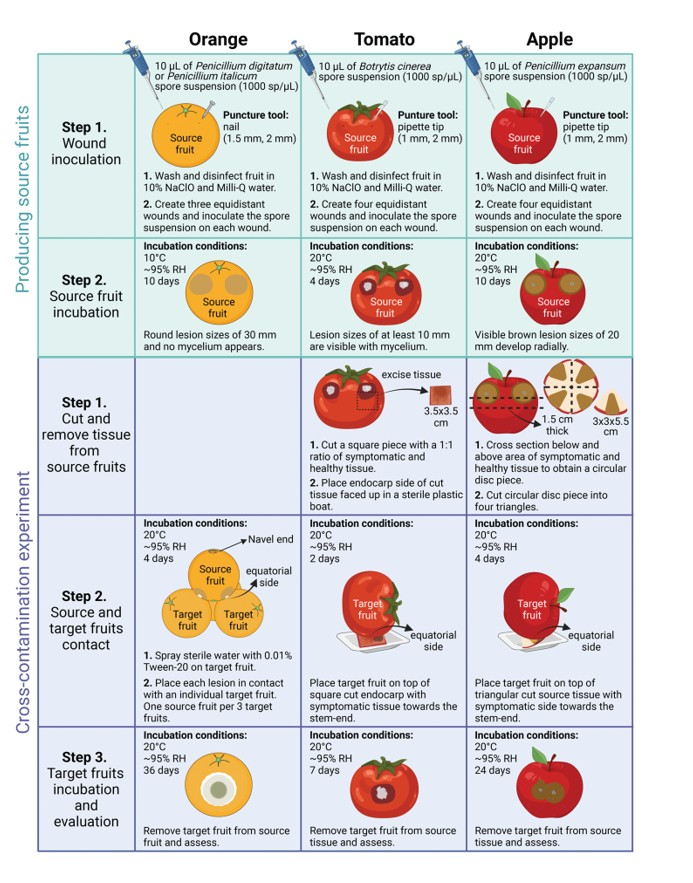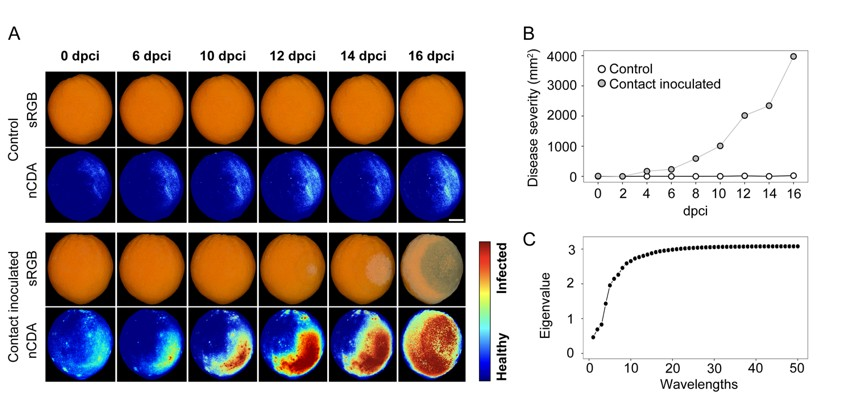品质至上,客户至上,您的满意就是我们的目标
当前位置: 首页 > 新闻动态
科学家利用Videometer多光谱成像系统研究果实病害
发表时间: 点击:421
来源:北京博普特科技有限公司
分享:
最近,科学家利用VideometerLab多光谱成像系统发表了题为“Non-wounding Contact-based Inoculation of Fruits with Fungal Pathogens in Postharvest”的文章,VideometerLab多光谱成像系统被广泛应用了植物病理学领域,采集植物病害光学指纹,助力植物病害表型组学研究。
基于非损伤性接触的果实采后真菌病原体接种
摘要
背景
真菌病原体在供应链的不同阶段对水果和蔬菜的质量产生重大影响,导致大量粮食损失。了解这些持续性真菌感染是如何发生的以及收获后条件下的进展对于制定有效的控制策略至关重要。
结果
在这项研究中,我们开发了一种可靠且一致的接种方案,以模拟收获后储存期间从受感染的水果到相邻健康水果的疾病传播。我们测试了相关水果商品的不同组合,包括橙子、西红柿和苹果,以抵抗有影响力的采后病原体,如指状青霉、意大利青霉、灰霉病和扩展青霉。我们使用用各种采后方法处理的水果和每种病原体的多种分离株评估了该规程的效果。我们优化了每种水果-病原体组合的感染组织来源和孵育条件。定量评估疾病发病率和严重程度,以研究感染成功率和进展。在评估点,除了接种杀菌剂敏感的青霉菌属分离株的杀菌剂处理的橙子外,所有试验的病害发病率均为80%或更高。尽管在该特定情况下疾病发生率较低,但值得注意的是,病原体仍然能够在不利条件下存活,这表明我们方法的稳健性。最后,在病原体存在后,肉眼可见前,使用多光谱成像来检测橙子中的早期指状青霉感染,。
结论
我们开发了一种非侵入性接种策略,可用于在收获后重现接触或聚集引起的感染。在水果商品和真菌病原体中观察到的高疾病发生率和严重程度值证明了所开发方法的稳健性、有效性和可重复性。该规程有可能针对其他病理系统进行定制。此外,这种方法可以促进水果-病原体相互作用的研究和创新控制策略的评估。
关键词:水果病害,霉菌,青霉菌,灰霉病,橙子,番茄,苹果,早期发现




Non-wounding Contact-based Inoculation of Fruits with Fungal Pathogens in Postharvest
Abstract
Background Fungal pathogens signi cantly impact the quality of fruits and vegetables at different stages of the supply chain, leading to substantial food losses. Understanding how these persistent fungal infections occur and progress in postharvest conditions is essential to developing effective control strategies.
Results In this study, we developed a reliable and consistent inoculation protocol to simulate disease spread from infected fruits to adjacent healthy fruits during postharvest storage. We tested different combinations of relevant fruit commodities, including oranges, tomatoes, and apples, against impactful postharvest pathogens such as Penicillium digitatum, Penicillium italicum, Botrytis cinerea, and Penicillium expansum. We assessed the e cacy of this protocol using fruits treated with various postharvest methods and multiple isolates for each pathogen. We optimized the source of infected tissue and incubation conditions for each fruit-pathogen combination. Disease incidence and severity were quantitatively evaluated to study infection success and progression. At the nal evaluation point, 80% or higher disease incidence rates were observed in all trials except for the fungicide-treated oranges inoculated with fungicide-susceptible Penicillium spp. isolates. Although disease incidence was lower in that particular scenario, it is noteworthy that the pathogen was still able to establish itself under unfavorable conditions, indicating the robustness of our methodology. Finally, we used multispectral imaging to detect early P. digitatum infections in oranges before the disease became visible to the naked eye but after the pathogen was established.
Conclusions We developed a non-invasive inoculation strategy that can be used to recreate infections caused by contact or nesting in postharvest. The observed high disease incidence and severity values across fruit commodities and fungal pathogens demonstrate the robustness, e cacy,and reproducibility of the developed methodology. The protocol has the potential to be tailored for other pathosystems. Additionally, this approach can facilitate the study of fruit-pathogen interactions and the assessment of innovative control strategies.
Keywords: fruit diseases, mold, Penicillium, Botrytis, orange, tomato, apple, early detection